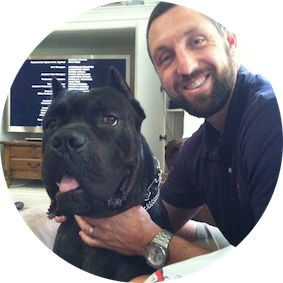Dogs shake or pant for several reasons, which are usually related to their physical or emotional state. They have physiological responses to their environment, such as regulating their body temperature by panting when they’re hot or shaking when they’re cold. Emotional triggers like excitement, anxiety, or fear can also cause panting and shaking. Sometimes, these behaviors can indicate pain or discomfort.
Here are 11 reasons dogs shake and pant:
- Anxiety and Stress
- Fear and Phobias
- Pain or Injury
- Temperature Regulation
- Canine Distemper
- Poisoning or Toxins
- Hypoglycemia (Low Blood Sugar)
- Cushing's Disease
- Seizures or Neurological Issues
- Side Effects of Medication
- Aging
Why Is My Dog Shaking and Panting?!
It's a question veterinarians get asked often by worried pet owners. These behaviors can be perfectly normal in certain situations (Chihuahua owners know this!). But they can also be signs that something more serious is going on. Shaking and panting together could indicate extreme stress, fear, or even a medical condition. In some cases, these symptoms could point to a more chronic issue, such as a heart problem or respiratory condition.
Let's explore the most common reasons you may notice your dog shaking and panting, and what dog owners can do about it.
11 Reasons Dogs Tend to Shake and Pant

1. Anxiety and Stress
Just like humans, dogs can feel anxious or stressed, and when they do, they may react by shaking or panting. Loud noises, a new environment, or even separation anxiety might cause your dog to tremble or breathe heavily.
It’s their way of coping with big feelings. If your pup tends to get the jitters, try to comfort them by using a calm voice, by giving them their favorite toy, or directing them to a cozy spot where they feel safe, like their kennel or dog bed. Sometimes, just being close to you is all they need to feel safe.
2. Fear and Phobias

Similar to anxiety, some dogs react to fear by shaking or panting. Things like thunderstorms, fireworks (and other loud noises), or even a trip to the vet can be scary experiences for your furry friend. When something really scares your dog, they might shake and pant as a response. It’s like their way of saying, "This is too much for me!"
If you know your dog has a specific fear of something predictable—like fireworks or thunderstorms—you can help by creating a distraction or a safe space.
Here are some ideas to help your dog work through fear:
- move them to a basement or other room in the house where the noise isn't as loud
- turn on the television or some music to help distract them
- consider getting them an anxiety vest (the compression against your dog's body helps calm them)
- for extreme fears or anxiety, ask your vet about prescription medication that can be used on an as-needed basis
3. Pain or Injury
When they're feeling pain, dogs can't just tell you something is wrong, so they may respond with behaviors such as shaking and panting, whining, and barking. Whether it’s a painful broken nail, an upset stomach, or something more serious, these behaviors can be your dog’s way of telling you they’re not feeling well. If your dog's shivering or panting is more frequent than usual or combined with other signs like limping or refusing to eat, it may be time for a vet visit to figure out what's going on.
4. Temperature Regulation

Many dogs shiver when they're cold, especially small dogs. Certain breeds—especially toy breeds—get cold faster than others. Shaking or shivering can be their way of warming up if they’re feeling cold. Make sure your pup has a warm blanket to snuggle up with at bedtime, and if you live in a cold climate, consider putting a sweater or coat on them for those winter walks.
On the other hand, panting is a way for dogs to regulate their temperature when it's hot out. Since dogs don't sweat like we do, panting is like their built-in air conditioning and a way to keep them from suffering from heatstroke. If you notice your dog panting and drooling excessively in hot weather or if your dog's gums appear bright red or dry, get them to a cool area right away and use a cool (not super cold) rag or sponge to cool down their belly.
5. Canine Distemper
Canine distemper is a serious illness that can cause shaking and panting, among other symptoms. It often affects puppies and unvaccinated dogs, leading to respiratory, gastrointestinal, and neurological issues. Dogs affected by canine distemper should be seen by a vet as soon as possible.
Look out for other symptoms that may indicate distemper, such as fever, coughing, lethargy, low appetite, diarrhea, or vomiting.
6. Poisoning or Toxins
If you've been a dog owner for a while, you likely already know that they're curious creatures who love to eat things that aren't good for them—like chocolate, houseplants, or pretty much anything in the house they shouldn't be eating. When a dog ingests something toxic, shaking and panting can be early signs of poisoning.
Other symptoms might include vomiting, drooling, or seizures. If you suspect your dog has gotten into something dangerous, it’s important to seek emergency veterinary care immediately. The quicker you act, the better the chances of a full recovery.
7. Hypoglycemia (Low Blood Sugar)
Low blood sugar, or hypoglycemia, can cause dogs—especially small breeds and puppies—to shake and pant in order to maintain normal glucose levels. If your dog seems weak, is disoriented, or is shaking and panting excessively, they might need a sugar boost. Your veterinarian can do a blood glucose test to diagnose hypoglycemia and run other diagnostic tests to determine the underlying causes.
Treatment for low blood sugar in dogs can range from simple solutions like diet changes and liquid oral glucose to more involved solutions such as hospitalization for IV fluids.
8. Cushing's Disease

Excessive panting could be a sign that your dog has Cushing’s disease, which occurs when a dog’s body produces too much cortisol. Cortisol is a hormone that helps regulate things like metabolism, the immune system, and stress responses, but too much of it can cause health problems in your pup. The condition is most common in older dogs, and it’s often caused by a tumor on the pituitary or adrenal gland.
Diagnosing Cushing’s disease can be tricky, as the symptoms often overlap with other health conditions. Your veterinarian might recommend blood tests, urine tests, and an ultrasound to confirm the diagnosis.
Look out for the following additional symptoms that may indicate Cushing's disease:
- increased thirst
- increased hunger
- swollen belly
- hair loss
- weakness
- lethargy
9. Seizure Disorders or Neurological Issues
Seizures and other medical conditions can manifest as shaking, muscle twitching, and heavy panting. If your dog has a seizure, it’s important to stay calm, keep them safe from injury, and contact your veterinarian right away. Depending on the cause, there are treatments that can help manage or reduce the frequency of seizures.
10. Side Effects of Medication
Certain medications can cause shaking or panting as a side effect. Whether it’s a new prescription or a change in dosage, this could be your dog’s way of reacting to the medication. If you notice this happening, it’s worth discussing it with your vet to see if the medication needs to be adjusted or if there’s an alternative option.
11. Aging

In their old age, a dog's body goes through changes much like ours do, and these can sometimes lead to shaking, panting, or other signs of general discomfort. One of the most common issues older dogs face is muscle weakness and joint problems, such as arthritis. Over time, your dog will lose muscle mass and strength, making it harder for them to move around.
You might notice that they’re slower to get up, have trouble climbing stairs, or seem stiff after resting. This muscle weakness can also cause trembling or shaking, especially in their legs. If your senior dog is experiencing joint pain or arthritis, you can help ease the pain by getting them an orthopedic bed and adding joint supplements to their diet.
What to Do For a Panting or Shaking Dog
Many dog owners worry when they notice their pup shaking and panting. In general, if the behavior is new, persistent, is accompanied by other symptoms, or if there have been changes to your dog's environment, it's best to contact a veterinarian to rule out any serious underlying issues.
While some shaking and panting can be normal, especially in certain situations like excitement or after exercise, it’s important to pay attention to the context. If your dog seems distressed or uncomfortable, or if these behaviors are happening out of the blue, seek professional advice to keep your dog happy and healthy.





